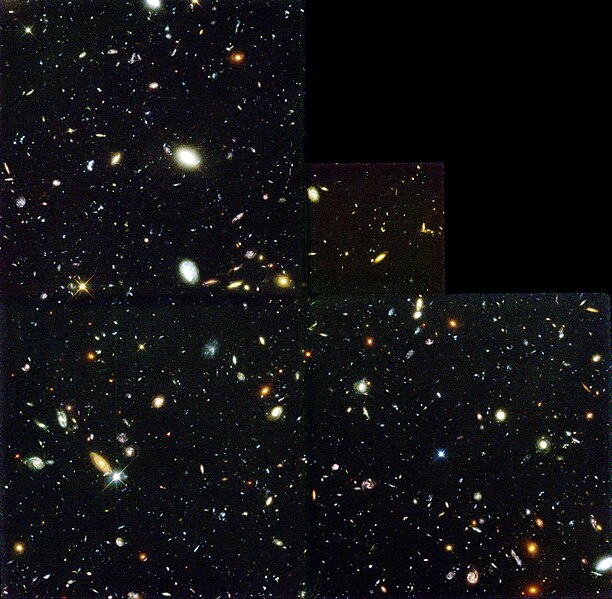This post is about Charge Coupled Device or CCD and
how it changed Astronomy.
The
concept of CCD was invented by Willard S. Boyle and George E. Smith at Bell
Telephone Laboratories.
In
their lab notebook, on 19 October, 1969 they developed the idea of a memory
device which they named as 'Charge Bubble Device' because it was an electronic
analog of magnetic bubble device.
And
few weeks later a device was designed, fabricated and tested.
Charge
Coupled Device is now used in digital cameras and Smartphones as an image
sensor.
The functioning of a CCD can be divided in two phases-
1. Exposure – CCD is made of lots of
individual pixels which collect light. Each of these pixels is actually a
photodiode that converts light into electricity. When light falls on a pixel a
free electron is released. If there are lots of electrons in a pixel it means
there were lots of photons which hit the pixel. The amount of time till the
shutter remains open is called the exposure time. In astronomy many exposures
are taken with the CCD shutter closed and open. The dark frame average image is
then subtracted from the open shutter image to remove dark current and other
factors.
2. Readout – The electrons thus accumulated
in each pixel are read out or counted electronically. In this process the
electrons are shifted along the semiconductor surface from one storage
capacitor to another and thus the information is stored. During the shifting
process pixels continue to collect light. So the shifting process should be
fast otherwise light may fall on a pixel already containing a charge. And it
can lead to Vertical Smear which is a vertical bright line that extends from a
bright source. During the readout time CCD cannot collect light. Only when all
the electrons are counted the CCD again becomes ready to accumulate another set
of electrons for the new image.
The digital cameras are described by the
number of pixels they contain. CCD cameras can have pixels in multiple of one
million. An M×N pixel camera tells us the number of rows (M) and columns (N) in
a CCD.
So a 1 megapixel camera with square shaped CCD will have 1024×1024 pixels.
It’s very interesting to notice that even before the concept of CCD was invented, NASA planned some projects which required an electronic solid state detector.
One
of the project proposed in 1965 was, Large Space Telescope which was later
called Hubble Space Telescope.
And
the first Wide field Planetary Camera (WF/PC) in Hubble Space Telescope used 8
Texas Instruments backside-illuminated 800×800×15 mu meter pixel three-phase
CCDs.
Here the backside illumination is the technique used
in CCDs. In this, the image is focused on the back side of Silicon so that the maximum
amount of photons are detected. But for this the thick wafer on which CCD is
built must be very thin.
 |
| The CCD used in ACS (Advanced Camera for Surveys) - www.spacetelescope.org |
The WF/PC produced many beautiful images. And it was
replaced by WF/PC 2 in December, 1993.
The second generation WF/PC 2 camera system with
corrective optics had four Lockheed frontside-illuminated 800×800×15 mu meter
pixel three-phase CCDs. Then a new camera named ACS (Advanced Camera for
Surveys) was installed in 2002. And it was also replaced in 2009 by WFC 3.
 |
| spacetelescope.org : A gravitational lens captured by WF/PC 2 |
 |
| WF/PC 2 |
Out of all the images taken with the cameras installed in Hubble Space Telescope, the deepest view of the universe was provided with the Hubble Deep Field images.
The first Hubble Deep Field image was captured with three WF/PC 2 CCD detectors. Separate images in blue, red and infrared were captured to make the true-color image.
After many such Deep Field
images, Hubble Ultra Deep Field image was taken with the Advanced Camera for Surveys
(ACS) in the Fornax constellation. In 2009 Hubble Ultra Deep
Field (HUDF) was taken with the Wide Field Camera 3 in infrared. Later in 2012
Hubble eXtreem Deep Field was released which was just the combination of many
exposures of UDF.
The last HUDF was released in 2014. It’s a composite image of
the exposures taken from 2002 to 2012 with the Advanced Camera for Surveys and
Wide Field Camera 3 of Hubble Space Telescope. The project was called the
Ultraviolet coverage of the Hubble Ultra Deep Field (UVUDF).
> You can see what Hubble Space Telescope is observing right now with WFC 3.
Spacetelescopelive.org























